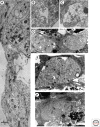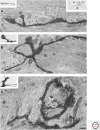Cellular strategies of axonal pathfinding
- PMID: 20591992
- PMCID: PMC2926747
- DOI: 10.1101/cshperspect.a001933
Cellular strategies of axonal pathfinding
Abstract
Axons follow highly stereotyped and reproducible trajectories to their targets. In this review we address the properties of the first pioneer neurons to grow in the developing nervous system and what has been learned over the past several decades about the extracellular and cell surface substrata on which axons grow. We then discuss the types of guidance cues and their receptors that influence axon extension, what determines where cues are expressed, and how axons respond to the cues they encounter in their environment.
Figures





References
-
- Attardi DG, Sperry RW 1963. Preferential selection of central pathways by regenerating optic fibers. Exp Neurol 7: 46–64 - PubMed
-
- Bagri A, Marín O, Plump AS, Mak J, Pleasure SJ, Rubenstein JL, Tessier-Lavigne M 2002. Slit proteins prevent midline crossing and determine the dorsoventral position of major axonal pathways in the mammalian forebrain. Neuron 33: 233–248 - PubMed
Publication types
MeSH terms
LinkOut - more resources
Full Text Sources
Miscellaneous
